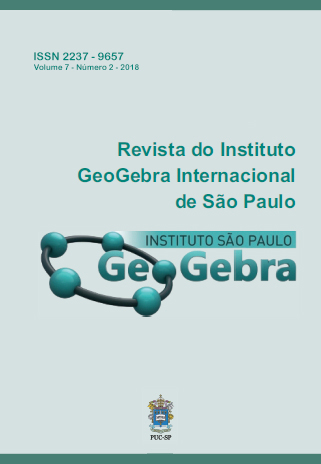Resolução gráfica de um problema de programação linear utilizando a folha gráfica 3D do GeoGebra
Keywords:
Software GeoGebra e a folha gráfica 3D, regiões admissíveis, constru- ções auxiliares, resolução gráfica de um problema de programação linear, solução ótima, pontos extremos.Abstract
O uso do software GeoGebra, tem sido recorrente para melhorar nossas capacidades de entendimento da matemática, sobretudo como uma ferramenta poderosa no auxílio ao ensino e consequente sucesso nos ambientes de aprendizagem. Neste trabalho, consideramos a resolução gráfica, com três variáveis de problemas de Programação Linear (PL), com recurso ao software dinâmico GeoGebra, a folha gráfica 3D. Problemas de PL no plano, são facilmente concebidos e resolvidos pelo método gráfico e analítico. Porém,quando as regiões admissíveis são poliedros (envolvendo três variáveis de decisão), a tarefa não é trivial. Requer construções auxiliares e alguma perspicácia como concluímos neste artigo. Assim, o objetivo principal é representar graficamente um problema de PL e determinar a sua solução (ótima) recorrendo ao ambiente gráfico do GeoGebra.
References
AIZIKOVITSH-UDI, E., RADAKOVIC, N. (2012). Teaching probability by using geogebra dynamic tool and implemanting critical thinking skills. Procedia Social and Behavioral Sciences 46, 4943-4947.
ARANGO, J., GAVIRIA, D., VALENCIA, A. (2015). Differential calculus teaching through virtual learning objects in the field of management sciences. Procedia Social and Behavioral Sciences 176, 412-418.
ARBAIN, N., SHUKOR, N. (2015). The effects of GeoGebra on students achievement. Procedia Social and Behavioral Sciences 172, 208-214.
BAZARAA, M., JARVIS, J., SHERALI, H. (2010). Linear programming and network flows. 4ªed. John Wiley & Sons, Inc.
BU, L., SCHOEN, R. (2011). TModel-Centered Learning: Pathways to Mathematical Understanding Using GeoGebra. Sense Publishers, Rotterdam.
CALIGARIS, M., SCHIVO, M., ROMITI, M. (2015). Calculus & GeoGebra, an interesting partnership. Procedia Social and Behavioral Sciences 174, 1183-1188.
CHAN, S., ISMAIL, Z. (2014). Developing Statistical Reasoning Assessment Instrument for High School Students in Descriptive Statistics. Procedia Social and Behavioral Sciences 116, 4338-4343 .
DOGAN, M., GUNER, P., SOYLU, M. (2012). A study of efficiency activity on logarithm. Procedia Social and Behavioral Sciences 46, 4449-4453.
DOS SANTOS, J. M. (2013). Programacion Lineal y GeoGebra. In: XVI Jornadas para el Aprendizaje y la Ensenanza de las MatemÁticas, Palma de Mayorca.
KANNAN, G., DINAKARAN, N., LAVANYA, N. (2004). A Graphical Approach for Solving Three-Variable Linear Programming Problems. Recent Developments in Materials Processing (RDMP--04). At Bharathiyar College of Engineering and Technology, Karaikal, India, Volume: Mar 2004.
KAVGIZMANLI, T., TATAR, E., AKKAYA, A. (2011). Analytic Analysis of Lines with Dynamic Mathematical Software. Procedia Social and Behavioral Sciences 15, 2505-2509.
KOLMAN, B., BECK, R. (1995). Elementary Linear Programming with Applications. Elsevier Science & Technology Books.
LINGEFJARD, J. (2017). Mathematical Modeling: applications with geogebra. John Wiley & Sons, New Jersey.
MEDINA, E., VALDÉS, L. (2015). Dynamic models as change enablers in Educational Mathematics. Procedia Social and Behavioral Sciences 176, 923-926.
PACHEMSKA, S., PACHEMSKA, T., ILIEV, D., KUZMANOVSKA, M. (2014). Analyses of Student's Achievement Depending on Math Teaching Methods. Procedia Social and Behavioral Sciences 116, 4035-4039.
PARIS, Q. (2016). An Economic Interpretation of Linear programmin. PALGRAVE MACMILLAN.
REIS, Z., OZDEMIR, S. (2010). Using Geogebra as an information technology tool: parábola teaching. Procedia Social and Behavioral Sciences 9, 565-572.
REIS, Z. (2010). Computer supported mathematics with Geogebra. Procedia Social and Behavioral Sciences 9, 1449-1455.
SAHAA, R., AYUB, A., TARMIZI, R. (2010). The Effects of GeoGebra on Mathematics Achievement: Enlightening Coordinate Geometry Learning. Procedia Social and Behavioral Sciences 8, 686-693.
VENEMA, G. (2013). Exploring Advanced Euclidean Geometry with GeoGebra. The Mathematical Association of America.
ZACHI, J. (2016). Problemas de Programação Linear: uma proposta de resolução geométrica para o Ensino Médio com o uso do GeoGebra. Universidade Estadual Paulista Júlio de Mesquita Filho, Instituto de Geociências e Ciências Exatas, Câmpus de Rio Claro.
ZENGINA, Y., FURKAN, H., KUTLUCA, T. (2012). The effect of dynamic mathematics software geogebra on student achievement in teaching of trigonometry. Procedia Social and Behavioral Sciences 31, 183-187.
Downloads
Published
How to Cite
Issue
Section
License
Submission, processing, and publication of articles sent to the journal and registration of the DOI at Crossref is free of charge.
Authors retain their copyright and grant the journal the right of first publication of their article, which is simultaneously licensed under a Creative Commons - Attribution 4.0 International license CC BY that allows others to share the article by acknowledging its authorship and initial publication by the journal.
The GeoGebra journal encourages its authors to register their work with information and communication management systems aimed at researchers, such as Academia.edu, Mendeley, ResearchGate, etc.


 10.23925
10.23925
